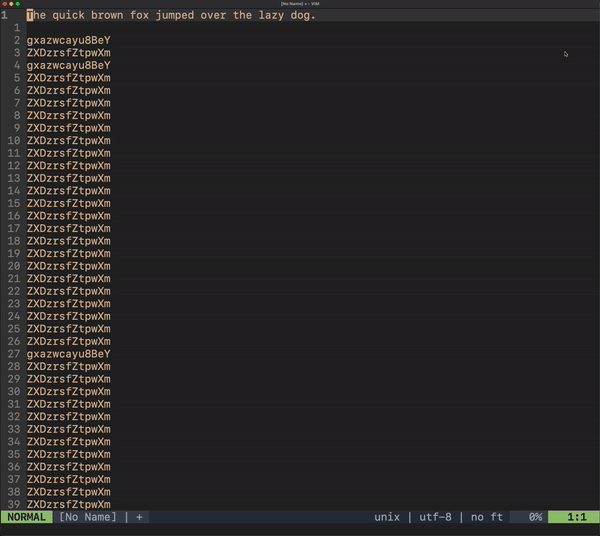In this post I would like to show a Vim1 trick I use often to do some repetitive editing tasks in a programmatic way.
This is best explained by discussing an example. Think that you have a long list of values with duplicates and your task is to remove the duplicates and get the set of unique values.
In my case, this kind of editing requirement is something which frequently comes up at work with data analysis queries. Often the values might come from a CSV, Excel sheet, or other source.
Using POSIX tools
If the order of the items do not matter, using sort and uniq tools is the
fastest way to get the desired output.
-
Visual select the lines you want to remove duplicates from,
gxazwcayu8BeY ZXDzrsfZtpwXm gxazwcayu8BeY ZXDzrsfZtpwXm VXAtmdTPRUjUp ZXDzrsfZtpwXm gxazwcayu8BeY ZXDzrsfZtpwXm VXAtmdTPRUjUp VXAtmdTPRUjUp VXAtmdTPRUjUp -
Run the following command on selection in Vim command mode,
:'<,'>!sort|uniq -
Selected lines from the first step should be replaced with following output,
VXAtmdTPRUjUp ZXDzrsfZtpwXm gxazwcayu8BeY
Using Python
As can be seen from the output of the previous command, the order of the items
in the list gets mangled when you use the sort command. This is where some
creative use of inline Python2 can be used to fix that.
Here’s an example of a script I’d usually write to remove duplicates while preserving order. Since this is just a demonstration of a Vim trick, I’m not going to explain too much on the Python code itself, but this inline script has to make sure following things are taken care of,
- Capture the text into a string -
s = """. Python multi-line strings3 are ideal for this use case. - Split the string into lines -
s.split() - Remove duplicate lines -
set(l.rstrip() for l in s.split())4 - Print the unique lines to standard out -
print('\n'.join(set(l.rstrip() for l in s.split())))
The important thing to keep in mind that the output from the command is what Vim replaces the text with. Hence why the text transformation script need to print to stdout.
With Vim it is pretty easy to undo(u) and experiment to get the
transformation you are looking for.
Here are all the steps,
-
Write an inline script and visual select the whole area,
s = """ gxazwcayu8BeY ZXDzrsfZtpwXm gxazwcayu8BeY ZXDzrsfZtpwXm VXAtmdTPRUjUp ZXDzrsfZtpwXm gxazwcayu8BeY ZXDzrsfZtpwXm VXAtmdTPRUjUp VXAtmdTPRUjUp VXAtmdTPRUjUp """ print('\n'.join(set(l.rstrip() for l in s.split()))) -
Run the following command on selection in Vim command mode,
:'<,'>!python3 -
Selected lines from the first step should be replaced with following output,
gxazwcayu8BeY ZXDzrsfZtpwXm VXAtmdTPRUjUp
Video demo
Here is a short demo of using the first method to remove duplicates from a long list of items.

In summary, I find Vim selection piping to be a powerful technique when the editing is of repetitive nature, but not too regular enough to write a macro. As long as writing a short inline Python script is faster than writing a separate script or a spreadsheet program when data is columnar, I find that Vim selection piping is powerful enough for a lot of tasks.
-
This is not specific to Python. Any programming language with good string manipulation functions would do equally well here. ↩︎
-
https://docs.python.org/3/reference/lexical_analysis.html#string-and-bytes-literals ↩︎
-
Python set order can be implementation dependent. ↩︎